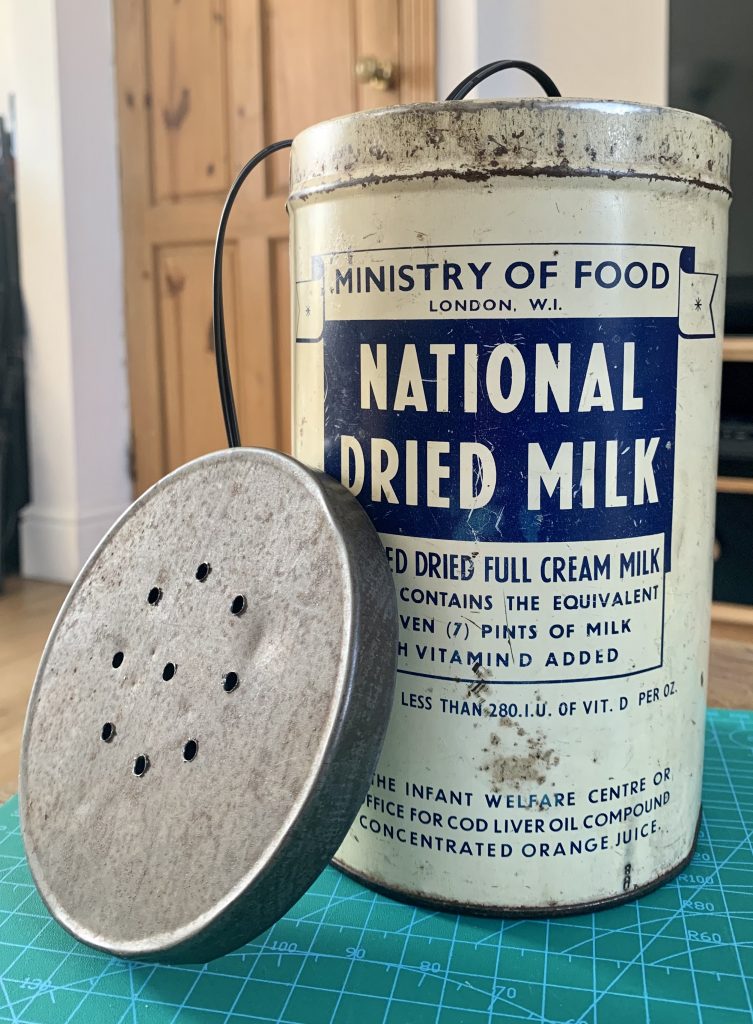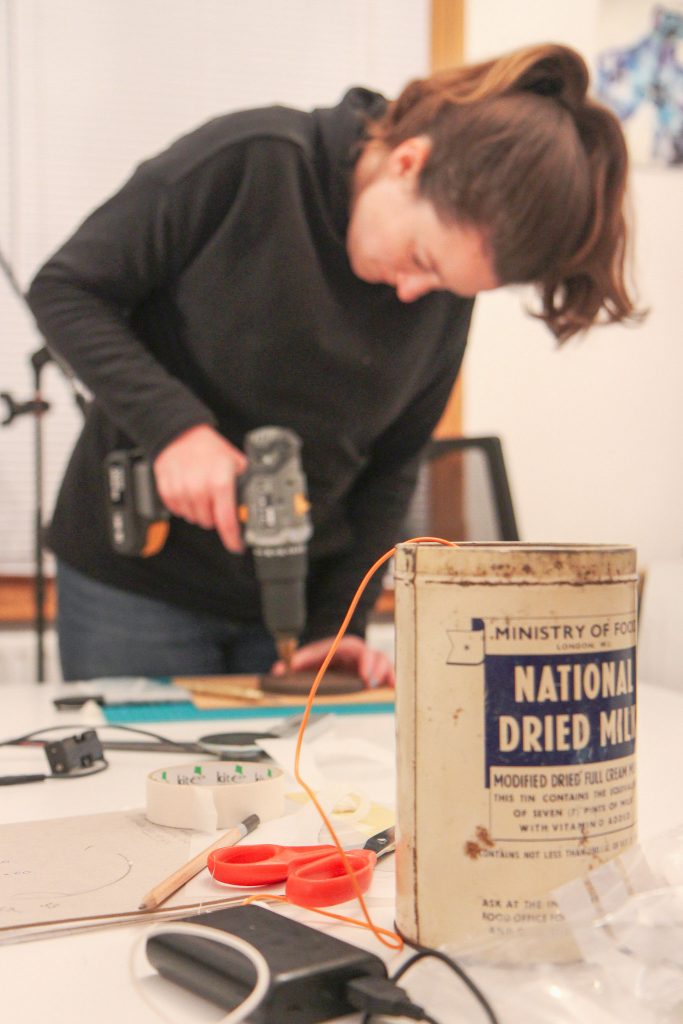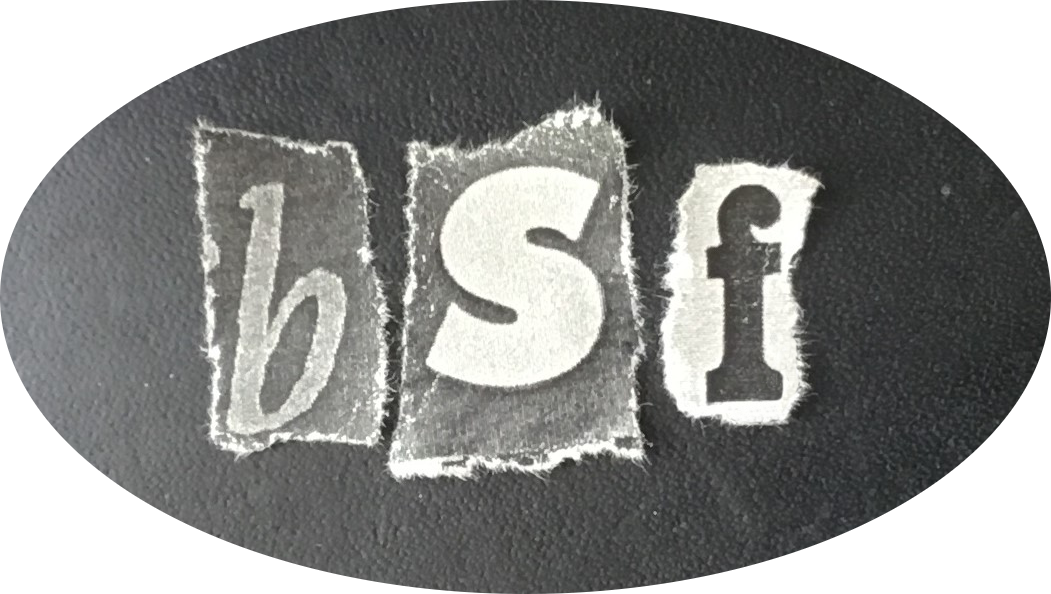by Kate Mahoney
On the Body, Self and Family project, we aim to explore the expansive ways in which women understood their health across their daily lives in late twentieth-century Britain. One way in which the women that we have interviewed for the project consider their everyday health experiences, is through their description of everyday health objects. BG, born in 1944 and interviewed in 2018, for example, recalled how her mother repurposed a National Dried Milk tin to serve as her family’s first aid kit.[1] Whilst the tin in question – a container for foodstuffs – did not have immediate medical connotations, BG drew on her own experiences to imbue the item with a purpose, emotions, and values that rendered it vital to her sense of their everyday health.[2] I therefore wondered if I could draw on our interviewees’ descriptions of “everyday health objects” to promote the project’s expansive definition of everyday health to a public audience.
In February 2020, I designed and led an activity titled ‘What Do Everyday Health Objects Sound Like?’ at a museum “late”, organised by the University of Roehampton’s ‘Surgery and Emotion’ team and hosted at the Royal College of Nursing. Janet Weston promotes the value in encouraging public audiences to listen to interviews because ‘the gestures, the performance, the tone and emotional content’ of recordings can be lost when the interview is presented in a written format.[3] I wondered if the act of listening to interviews might be enhanced further if listeners could simultaneously engage with a historical object being discussed by the interviewee. This activity could lend a tangibility and tactility to the events and experiences that the interviewee was describing. I selected three “everyday health objects” that feature in our interviews – the National Dried Milk tin discussed by BG, a black plastic shopping back, and a small bin for sanitary items. After buying versions of these items online, I inserted MP3 players containing the relevant interview extracts inside them, and plugged headphones directly into the object; this generated the sense that participants were listening to the stories of the objects themselves.

Whilst I received positive feedback for the activity, aspects of its design limited participants’ engagement with both the historical objects on display and the interview extracts that they contained. Many participants felt uncertain about picking up and wearing the headphones without my encouragement. I also found that participants spent most of their time holding the headphones to their ears, so were unable to simultaneously engage with the objects. I wondered if these issues could be remedied by creating a historical health object that played an interview extract on its own accord through an integrated speaker, when a participant either touched it or picked it up.
I decided to experiment with whether this was possible using a National Dried Milk tin and oral history interviewee BG’s testimony. National Dried Milk was introduced in 1940 as part of the Ministry of Health’s National Milk Scheme. Pregnant women, and mothers with children under the age of one, were entitled to seven pints of free or subsidised milk per week on top of their normal entitlement.[4] The tin held enough powder for these seven pints. Dried milk was decontrolled in 1954 as rationing in Britain was curtailed. Its distribution was reallocated to local authorities and it ceased to be produced in 1976.[5] Given their widespread distribution, it can be safe to assume that National Dried Milk tins featured in almost every British home that contained infant children in the immediate post-war period. When discussing her family’s National Dried Milk tin, BG closely associated it with being a child growing up shortly after the Second World War, as the extract I used demonstrates:
‘And we had orange juice. We were fortunate in a sense of being babies after the War because we had a good diet. And we had things like that. When my mother was feeding – she wasn’t breastfeeding – but when she was feeding Michael, it was National Dried Milk, in the big tins. I remember the tins because she – that’s right! – she used one as a first aid thing as well. So, there would be Germolene, iodine, and bandages, and things like that all rolled up. It was a very big, tall tin. So, that was for cuts and grazes, and I remember I always had grazes on my knees’.[6]
The “everydayness” of the National Dried Milk tins means that they are readily available to purchase on eBay for under £10. It felt exciting to create a responsive object from a genuine historical artefact that accurately matched the item being discussed in the oral history interview. I did debate whether converting a historical object into an art or exhibition piece would in some way deface the object, tampering with its historical relevance by altering its original structure. In order to incorporate a speaker into the object, for instance, I had to drill holes into the lid of the tin so that the participant could clearly hear the recording that it contained. I justified the changes that I made to the tin on the basis that they are readily available to buy and, as BG demonstrated, have historically been repurposed to perform new tasks. I hoped that my reformulation of the tin could also be situated within this narrative of reuse.

In constructing the tin as an object that told its own story, I first uploaded BG’s oral history extract onto a Bare Conductive Touch Board, which is powered by a USB power bank. The Touch Board enables you to turn any conductive object into a sensor or switch which can be used to trigger a sound to play. Drawing on my somewhat shaky soldering skills honed in Year 8 Product Design, I built a battery-powered amplifier speaker from Kitronik, which connects to the Touch Board via a mini jack. I then used copper tape and a crocodile clip test wire to connect the surface of the tin to the Touch Board. This ensured that the Touch Board knew to trigger the interview recording when someone touched the tin. I drilled holes in the lid of the tin to replicate the design of a telephone speaker, before gluing the amplifier speaker to the underside of the lid. To save the contents of the tin rattling around, I constructed a cardboard stand to go inside it, which held the power bank and Touch Board in place.

The National Dried Milk tin remains a work in progress. The capacitance levels, which the Touch Board uses to sense touch, are currently affected by the USB battery pack and speaker being inside the tin. This means that the tin only responds to touch when the battery pack is placed outside the tin, and its lid remains off. However, I am working on a solution that would mean that the tin responds to touch when all elements of its circuit are contained inside. It still feels very satisfying and engaging to hear an “everyday health object” tell its story simply by tapping it. Unfortunately, the curtailment of public engagement events due to the COVID-19 pandemic has meant that I have been unable get feedback on the National Dried Milk tin from members of the public. One area I would like to explore is how the tin depicts childhood health experiences. By combining BG’s testimony with the historical object that she discusses, the tin provides a sense of the changing size and scale of the objects and environments that informed her health experiences as she grew up. In her interview, BG repeatedly commented on the size of the tin. She remembered how National Dried Milk came in ‘big tins’, and recalled that her mother was able to repurpose one as a first aid kit because it was a ‘very big, tall tin’.[7] Interacting with the tin as an adult, it has clearly diminished in scale – I would unscientifically say that it is a medium-sized object. However, when holding the tin whilst listening to BG’s extract, it immediately becomes clear that the object would appear far larger and grander when held in the hands of a child.
I wonder if part of the reason why I embarked on this making project is because BG’s description of the tin really resonated with me. Growing up, my parents stored our first aid kit in a repurposed ice cream tub that was stored on the top shelf of one of our kitchen cupboards. I remember feeling a sense of excited pride when I had sustained a cut or a graze that warranted a plaster from the ice cream tub, and I was always disappointed when they did not. It felt almost ceremonial when my parents were obliged to bring the ice cream tub/first aid kit down onto the kitchen counter; a plaster was a badge of bravery and honour. I am therefore wary of the extent to which I might imbibe BG’s extract with the feelings that I associate with my own childhood health experiences. However, I also think that there is value in listening to these feelings, perhaps as a way to speculate how others might respond to the National Dried Milk tin in a public space. Certainly, when my partner saw the tin, and heard our participants’ story, he was immediately reminded of the fact that his mother stored their family first aid in an old metal biscuit tin. I look forward to using the tin to explore with others how everyday health objects have informed their own health experiences across the course of their day-to-day lives.
[1] BG, interviewed by Kate Mahoney (25 January 2018).
[2] Tracey Loughran, Kate Mahoney, and Daisy Payling, ‘Women’s voices, emotion and empathy: engaging different public with “Everyday” health histories’, Medical Humanities, forthcoming.
[3] Janet Weston, ‘History at Large: Oral Histories, Public Engagement and the Making of Positive in Prison’, History Workshop Journal, Vol. 87 (Spring 2018), pp. 211-223 (p. 217).
[4] Pam Carter, Feminism, Breasts and Breast-feeding (Basingstoke: Palgrave Macmillan, 1995), p. 54; Robert Mackay, Half the battle: Civilian morale in Britain during the Second World War (Manchester: Manchester University Press, p. 242); Richard Titmuss, Problems of social policy (1950), quoted in Pete Alcock et al. (eds.), Welfare and wellbeing: Richard Titmuss’s contribution to social policy (Bristol: Policy Press, 2001), p. 84; Ina Zweiniger-Bargielowska, Austerity in Britain: Rationing, Controls, and Consumption, 1939-1955 (Oxford: Oxford University Press, 2000), p. 131.
[5] National Archives, ‘Ministry of Food and Ministry of Agriculture, Fisheries and Food: Registered Files: National Dried Milk (NDM Series)’, available at https://discovery.nationalarchives.gov.uk/details/r/C10709 [accessed 13 April 2021].
[6] BG, interviewed by Mahoney.
[7] BG, interviewed by Mahoney.

